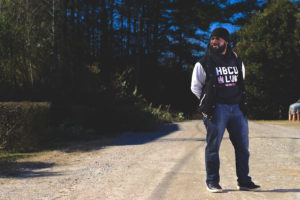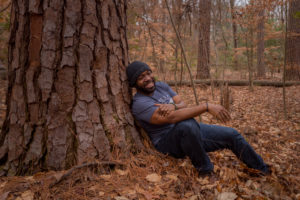By Dr. Thomas RaShad Easley
Dr. Easley will present Relationships, History, Hip Hop and Forestry: Thinking About Diversity and Inclusion at ELA’s Conference & Eco-Marketplace on March 4.
Working remotely in Raleigh, NC, has been challenging and rewarding. It is challenging because I usually work in New Haven, CT, and it means not seeing co-workers and students on a daily basis. However, the rewards are I can get more work done quickly, conversations are more personal, and the temperature is warmer. The warm temperatures incite me to go outside and go out a particular way. I go outside barefoot, stand on the soil, and breathe deeply while looking up at the sky. It does not matter if it is day or night; I love going outside and centering myself on the soil. Some call this grounding or centering. Being centered reminds me that I need to slow down and be observant. Being centered also reminds me that where I live, this space did not always look like this.

In many developed places, the way they look in 2021 would look completely different in 1821. These places would be more forested, and it would not be as easy to get around, especially in a vehicle. When I think about reconnecting with the forest, I think about how the forest may have looked before now and ask myself, would I want to be in that environment? Today when I go outside to a park or a forest, I notice the people as well. I almost feel like the way we speak about reconnecting with the forest is devoid of connecting with each other. Adding anthropomorphic qualities to the outdoors without establishing a trusting relationship with one another is out of line with nature. Therefore, for me to connect with the forest, I must connect with people.
I feel the way we talk about the forest is similar to the impact of COVID 19. I am constantly thinking about my health overall, meaning I think about my physical health, mental health, emotional health, spiritual health, and financial health. I recognize that there are other levels of health, but these, in particular, I think most of the readers coalesce with the categories I identified. If you only run for your physical health, what happens to other parts of your body without stretching? Sore muscles, aching joints, you keep your heart rate elevated excessively without cooling down, and other parts of your body go neglected. Eventually, your body will pay a price that you do not want to feel. Back to COVID 19, while we are wearing masks and staying inside, what other illnesses would you be in danger of contracting if you are not aware? Not moving stiffens the body and does not exercise your lungs. Conditions tied to lack of movement can harm you, like diabetes, stress, and cabin fever.
Back to the forest, if you reconnect with the forest with no understanding of where you are going, what you should or may expect, and the history that has led to why you or your community are not familiar with the forest. How do you think you would walk into a forest? I cannot answer this question for anyone because I have been connected to the outdoors my entire aware life. The forest has always been part of my existence, from childhood gardening and camping in my teens to teaching, exploring, and most recently using the forest as a place to become centered. I feel that the message of reconnecting with the forest without being sensitive to what others have or have not experienced sounds ideal and devoid of thoughtfulness.
I do not say only to reconnect with the forest but also to reconnect with yourselves. If you are in a safe community, but you do not know your neighbors, how about connecting with them? If you live near or in a forest, can you be a steward of this resource without taking away from the forest or replenishing the landscape?

In conclusion, do not reconnect with the forest without connecting with other people. To the people that are promoting this message, share this message with more nuance and information. For those who are very comfortable in the forest, if you have not been in a different environment that may appear to be distanced or separated from the forest, like some urban settings, go to those settings and learn why the people are disconnected. Learn other ways of inviting people to the forests by promoting this ideal through a relationship lens and not a personal ideal lens.
About the Author
Dr. Thomas R. Easley has spent most of his career as a diversity professional and a forester. As a diversity professional, he has focused on recruiting, retaining, and diverse talent in natural resource disciplines. As a forester, he has worked with landowners and citizens on land management and stewardship. Thomas earned his undergraduate degree in Forest Science from Alabama A&M University, his master’s degree in Forest Genetics from Iowa State University, and his doctorate in Adult Education from NC State University. He is the Assistant Dean of Community and Inclusion at the School of Forestry and Environmental Studies at Yale University.
***
Each author appearing herein retains original copyright. Right to reproduce or disseminate all material herein, including to Columbia University Library’s CAUSEWAY Project, is otherwise reserved by ELA. Please contact ELA for permission to reprint.
Mention of products is not intended to constitute endorsement. Opinions expressed in this newsletter article do not necessarily represent those of ELA’s directors, staff, or members.

